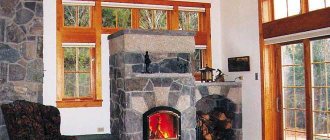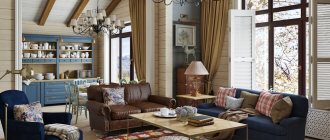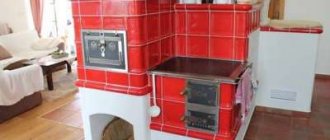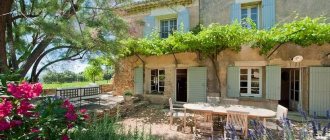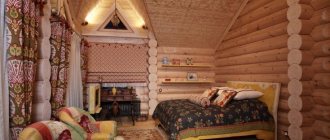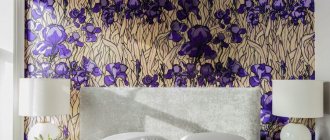The stove has been used for heating homes for a long time. This is a universal hearth that not only provides heat, but is also used for cooking. The Russian stove in the interior has great advantages compared to a fireplace: it retains and releases heat for a long time, it does not need to be lit often. Every year, the use of traditional heat sources is becoming increasingly popular in country houses and modern interiors.
Fireplace in a wooden country house
Russian stoves in the interior
A stove in the interior has great advantages compared to a fireplace: it retains and releases heat for a long time, it does not need to be lit often.
Many models of beautiful Russian stoves are particularly economical and easy to use. It is simply impossible not to adopt such a “miracle unit”. Considering that thoughtful design significantly changes the atmosphere in the house.
Design Features
A Russian stove is easy to recognize by its design features: traditionally it has a stove bench (polati), is quite massive, often with numerous shelves for various kitchen utensils. The cooking chamber is located deep in the oven, so a special grip and skill are required to cook food in it. The basis is a guard; there are usually two dampers for smoke. Between the cooking chamber and the mouth there is a gas threshold, a wall, thanks to which the combustion products are retained under the roof and utilized more completely.
The second important design element is the inflow. It can be completely ordinary or combined with a fireplace.
Also, all furnaces can be classified according to the size of the structure:
- small;
- average;
- big.
A small dacha is often equipped with a compact stove, but a huge country house can be complemented by an unusually large structure of complex design and ornate decor.
Advantages and disadvantages
The stove, conveying the old Russian style, will be an effective addition to many interior compositions. From the point of view of efficiency and functionality, this heating option also has many advantages:
- Long cooling time;
- Good heat conservation;
- High level of efficiency;
- Long service life;
- Design safety.
However, the shortcomings are worth mentioning. The most serious disadvantage is the heat generation higher than 1 m from the floor. However, some improved designs, which involve the installation of a special smoke circulation channel, also allow the floor to be heated.
Also, a stove as a heating device requires a specific type of raw material. Firewood needs to be found, purchased, delivered and storage space organized. Fuel consumption in models of any type is quite high. It is worth considering the fact that not every interior can fit into a stove project in an ethnic direction.
Tile - man-made beauty
This is a beauty created from different types of clay.
The manufacturing technology came from ancient Babylon and has survived to this day. The tile is a box shape, thanks to which heat retention increases significantly.
This is a piece and expensive finishing material. In past centuries, only very wealthy people could cover a stove with tiles.
Beautiful boxes, each with an individual design, were incredibly expensive, but were in great demand.
Nowadays, tiles are also popular.
Materials for the Russian stove
The design of a country house stove will largely depend on the material used. The traditional design was “sculpted” from clay. More modern models were created from brick. Stoves made of cast iron and steel also played an important role.
These are the so-called potbelly stoves. For many, they are associated with something unsightly and rude, but the modern range of mobile and compact heating devices allows you to choose quite sophisticated options.
Brick
Beautiful brick stoves for the home are the dream of true romantics and fans of Slavic flavor. A special advantage of the structures is the “breathable” material. A brick fireplace is a specific microporous body. It releases moisture vapor into the air, and when it cools, it takes it back. A stone heating unit is not capable of this.
A well-designed stove is useful for both heating and cooking. Many models of brick Russian stoves also work as a barbecue or grill.
You can build a brick stove in a small country house or in a luxurious spacious cottage. However, it is better to trust the laying of any type of structure to professionals, avoiding dubious experiments with stove-making amateurs.
Clay
A simple log house of poor people was always complemented by a clay stove. In the modern format, only finishing is made from this material and the sunbed is lubricated. Such a fireplace stove will look luxurious in the interior of a wooden house in a rustic style.
If the heating product is made exclusively on clay, then it will need to be constantly restored. It is necessary to grease and plaster at least once a year.
Cast iron
A wood-burning fireplace made of cast iron has amazing heating properties. The traditional potbelly stove appeared in the 19th century. Initially, such stoves were actively used by the Danes and Germans, and then by the Slavs.
A cast iron fireplace is like a fire: it warms you to the bone if you are in close proximity to it. If you move a decent distance away, the heat will be very soft and delicate. It does not dry out the air.
It is worth noting the disadvantages. Even a relatively small stove with cast iron elements will be very heavy. Huge structures are so heavy that they require strengthening the foundation (in some cases). In addition, cast iron is quite expensive when it comes to expensive materials.
A simple potbelly stove in the interior of a miniature wooden house will always look very stylish. A small unit with ornate “old-fashioned” decor and wooden log walls, a cozy blanket with embroidery and original patterns, indoor flowers - all this will give a person a feeling of calm, relaxation and privacy.
Steel
By analogy with classic cast-iron structures, steel stoves began to be produced. In large units, some elements (for example, the firebox) are replaced with steel ones.
Almost always, the fireboxes of steel furnaces can be lined - they are laid out with fireclay bricks. This is necessary to give the fabric greater heat resistance. You can additionally install tiles on the steel body. It is very fashionable to decorate fireboxes with natural or artificial stone.
Steel structures are much lighter than cast iron prototypes. They are much cheaper, much more mobile in terms of movement (if we are talking about devices like potbelly stoves).
Types of facing tiles
Finishing the stove with plaster is gradually becoming a thing of the past, and lining various types of stoves with tiles is becoming increasingly popular. Manufacturers offer various types of facing tiles. They differ in composition, production technology and design ideas.
- Clay based tiles . The most common type. It includes classic tiles, durable fireclay, exquisite terracotta and other types of tiles.
- Tiles based on natural stone . Marble tiles take pride of place in this category. Even the most severe critic will appreciate the marble-lined stove.
- Tiles based on artificial stone . The main component of the sample is cement. On its basis, with the help of various additives, a durable facing material is formed.
Variety of cladding Source kamin-spb.ru
When determining the type of tile for finishing a stove, it is necessary to consider the requirements for it. Let's take a closer look.
Additional materials
Auxiliary parts and additional materials for a traditional Russian stove are not only functional elements, but also serve as effective decor. When working on the creation and design of a stove with a stove bench, you may need the following:
- brick;
- sand;
- accessories for stoves;
- grate;
- valves;
- corners;
- fireclay slabs;
- fireclay brick;
- tile;
- ceramics;
- stone cladding;
- basalt insulation.
The old Russian stove is very economical in everyday life. She will decorate a modern country cottage, and housewives will appreciate her ability to prepare original dishes.
Cladding technology
Furnace cladding can be done in two ways: with glue or with metal profiles without glue. Before cladding, it is necessary to carry out comprehensive preparation.
How to prepare for cladding
Before tiling the stove, you must:
- Clean the stove from plaster. To facilitate the process, you can use a spray bottle. Once the surface is wet, removing the plaster with a spatula is not difficult.
- Remove remaining particles with a brush. To do this, re-wet the surface of the oven, then clean it. The seams are deepened. Cleaning is done with hand tools, or you can use a grinding machine.
Cleaning with a grinder Source rems-info.ru
Cleaning by hand and with a drill with attachments Source gidpokraske.ru
Important! If you plan to line a new stove, then after finishing the masonry you need to wait six months for the stove to settle!
- Prime the surface of the oven. This will ensure adhesion and additional protection. It is advisable to prime two layers. Before applying the second coat, you need to make sure that the first coat of primer is dry.
Wall priming Source vse-otoplenie.ru
- Level the surface using a 10 mm thick clay mortar. Differences in the wall are unacceptable. The clay mixture is applied to the surface with a spatula and leveled using the rule. The corners are secured with metal corners.
- Lay the reinforcing mesh, pressing it into the solution before it dries, then leave the walls to dry.
- After drying, apply final priming and leave the oven until completely dry.
With smooth walls, the mesh can be stretched without leveling. Source stroyfora.ru
Features of masonry
A modern country house requires a special approach to the laying and design of such a complex and powerful heating unit. First they make a backfill - a chamber. It acts as a kind of battery, retaining heat in the house.
The cooking chamber is covered with a roof. It is designed strictly according to the formwork - plank or metal. When laying bricks, they are placed on both sides at once. The angle of inclination will depend on the shape of the arch. This is necessary so that the load is evenly distributed throughout the structure. At the end of the work, the master forms a wedge castle from brick.
The chimney is installed in the furnace itself. The height of the element must be higher than 5 m from the level of the blind hearth. There are no horizontal sections or turns needed. A well-formed vertical (like for a fireplace) is enough.
Video description
The video explains how to properly light a stove:
- The stove will not allow you to maintain stable heat in the house. When the firebox is loaded with fuel and it flares up well, the interior is warm and even hot. When the wood burns out, it becomes noticeably cool. The floor will always be cold. In the most severe frosts you will have to wear felt boots.
Felt boots instead of warm socks Source yandex.net
- We will do a lot more house cleaning. Soot particles are constantly scattered throughout all rooms, settling on the surface, causing a characteristic dark coating to appear on them.
You will have to regularly clean the pipes Source m-pech.ru
- We must not forget that any oven, even the most compact one, is a bulky structure. Its installation will “eat up” a significant part of the free space. When the house is small (6 by 4 or 6 by 6), this becomes especially noticeable. Therefore, it is worth considering whether stove heating is needed and how it can be replaced.
Compact mini Russian stove is more for beauty than for heating Source pechiexpert.ru
Where is a Russian stove installed?
In ancient times, at the stage of building houses, they first of all determined where the stove would be located in the house, as well as the bathhouse on the estate. And if not everyone had steam rooms, then they simply could not do without a heating unit.
When choosing the optimal location, the operating principle of the stove, the possibility of further connection of the chimney and ease of maintenance during operation are taken into account. Fire breaks must be calculated - the distance between heating surfaces and walls made of flammable materials.
If the cottage is small, then it is better to place the stove as centrally as possible in the house. The same rule is relevant if the country house is entirely wooden.
In the living room
If the house is large and has many rooms, the ideal place to install the stove is the living room (even if we are not talking about traditional large units, but about miniature potbelly stoves or modern electric fireplaces).
For a large house it is better to create brick structures. Such a stove will warm up spacious rooms well. Typically, the living room is the center of the home.
By placing a stove in it, you can warm up all the rooms. Of course, the design will take quite a lot of time, but it is at the planning stage that it is important to take into account all the subtleties.
For example, to heat a village house consisting of four rooms, the stove is placed at the junction of the two main rooms. The “antique” format of the stove – with a stove bench – will look good in the living room.
Installation in the kitchen
Installation in the kitchen is the second common option for placing a stove in the traditional Russian style. As a rule, this technique is used in several cases:
- Only one room needs to be heated. Usually this is the kitchen or remote living room. A similar need arises when there is a good heating system throughout the house (for example, a gas boiler with a water circuit) and there is a shortage of heat in one of the rooms. Often, it is the kitchen that is being completed or its main structural components are being changed, which requires additional heating.
- A stylish Dutch or Russian “mazanka” skillfully emphasizes a thoughtful interior. Experiments with gastronomic-themed decor and decorations in ethnic style very often go well with the decoration of expensive kitchen locations in country, ethnic, and rustic styles.
- The stove plays the role not so much of a heating device, but rather of a device for cooking. A well-formed design and skillfully selected place will allow you to bake delicious pies, heat a vat of water, experiment with a device with an original barbecue system or grill.
The stove in the kitchen is also located in very small houses. In this case, it is the heating element that becomes the “hot heart” of the whole house. The well-thought-out design of the stove helps to correctly delimit space and divide a compact location into zones.
Basic operating rules
A stove is a complex mechanism that requires special care. Open fire is a great danger, especially for wooden buildings. It is proper care and compliance with safety regulations that guarantee a safe and comfortable life.
Safety
The first and basic rule is not to leave an open fire unattended. Before leaving, it is important to make sure that absolutely all the coals are extinguished and that there are not a single spark around. Negligence and inept operation of the stove are the main causes of fires. If everything is properly arranged, then the risk of an unwanted fire is practically eliminated. The second and no less important condition is to keep children out of the system. No matter how smart a child is, he will not be able to give a full account. It is important not to leave children alone with a hot stove.
A house project with a Russian stove will appeal to all family members Source tunnel.ru
For safety, you should cover the floor in the area where fire may enter with non-combustible material. Typically, a thin metal sheet or tile is used for such purposes. It also wouldn’t hurt to put up a screen or protective screen to catch dangerous hot wood chips and coals.
Service
The heating system elements must always be in good condition. For long-term operation without complications and breakdowns, it is important to carry out regular diagnostics and prevention. This work includes cleaning the chimney from ash and removing ash from the grate. Before each heating season, it is important to inspect all elements and, if there are faults, try to eliminate them.
The stove must be prepared for use before each season Source kaznews.kz
How to decorate a stove
There is nothing more original than the use of authentic materials and extravagant techniques in the design of modern apartments. The design of the Russian stove is quite unusual and can complement the beautiful design of the room.
If once the stove played a functional role and was the “center of everyday life” in a home, now its purely aesthetic role has increased. An impressively designed and decorated stove will enrich any modern interior.
Considering the fact that stoves can also be placed on the street, the entire private sector is transformed as soon as a cozy and “elegant” fireplace appears on the site.
Decorating the stove with tiles
Tiles are three-dimensional ceramic tiles that are used for finishing stoves, facades of buildings, and any other structures. The decoration has one distinctive feature - the rump. This is a box with holes through which the decor is attached to the wall.
Tiles come with a smooth surface and a relief canvas, plain and painted with bright patterns, rectilinear design and complex shapes. The decor can be turned into a monochromatic elegant panel or you can create a complex colorful installation with an abundance of decorative techniques.
A special artistic merit of such jewelry is majolica, which can change color at different times of the day. The decoration will show its qualities well in spacious, bright rooms.
The design of a Russian stove using tiled elements has the following advantages:
- Hygiene. They do not accumulate dust and dirt, do not darken over time and are not deformed. The special composition of the glaze does not allow soot and carbon deposits to penetrate inside the decorative ball.
- Highest level of heat capacity. The current eco-friendly format of modern rational heating of housing involves the use of only those heating devices whose efficiency is as high as possible. Tiled decor has a special heat capacity, improving the technical characteristics of the stove as a whole.
- Long heat dissipation. The oven cools down much more slowly.
Decorating a Russian stove with tiles is a complicated matter. Not every stove maker will undertake such work. Ideally, several specialists are involved in the work at once - an experienced stove maker or ceramist, as well as an architect or designer artist.
Plaster and paint
A classically plastered stove looks beautiful and cozy. There are many reasons why the old format of finishing heating units has retained its relevance today:
- Plaster allows you to level even a crooked structure, making the stove more elegant and attractive;
- A beautiful finish gives the old structure a fresh look.
- A large number of types of plastering and a solid range of materials allow us to implement any design project.
The easiest way to decorate a stove after plastering is to whitewash it.
You can do this yourself. A cheap and simple method will not allow you to use the stove to its full potential, since the bleached surfaces will get dirty. Another option (more practical) is the use of paints. If you cover the fireplace with oil and enamel compounds, you can increase heat transfer. Glossy and shiny paints work in the opposite direction. Formulations containing oil may darken under prolonged exposure to high temperatures.
Decorating the stove with tiles
Tiles are an expensive design material for finishing stoves. There is an excellent alternative (more attractive in terms of pricing) - tiles. Tiles or ceramics are presented in such a wide range that such decorative elements can be found in any form. They are suitable for creating unimaginable panels and complex decoration.
Another alternative option is porcelain stoneware or artificial stone. This is a relatively inexpensive material that looks magical in any interior.
The slightly rough textured background is complemented by wooden decorative elements. It turns out very colorful.
Decorate with household items
There are a lot of options for designing a stove in terms of decorative elements. It all depends on the specific stylistic direction in which the stove itself is presented:
- "a la russe";
- hut;
- tower;
- Noble Nest;
- estate in neoclassical format.
An apartment or house decorated using several stylistic concepts at once looks even more interesting. If desired, even a boiler or fireplace corner can be decorated in an incredible way.
Beauty majolica
The tiles, painted with bright fiery colors and covered with a durable layer of glaze, came from the Mediterranean.
Ancient Roman traders brought it from Mallorca. The area was famous for its tin-lead painting on ceramic tiles and pottery.
Glazing serves as another layer that retains heat inside the finishing material, so majolica was in demand as an excellent type of cladding.
Only wealthy people could decorate their stoves with such beauty.
A la russe
The “a la russe” style involves the use of traditional authentic elements of Russian life. Once upon a time, classics were written about stoves with such decor. Shelves were placed near the whitewashed hearth.
Wood is an absolute favorite. The main decorative elements are samovars, brooms and spinning wheels, animal skins (not exotic) and towels with embroidered ornaments. It is not at all necessary to decorate the stove with drawings. A perfect white background is enough.
Briefly about the main thing
A small stove for a country house will take up minimal space in the room. Despite its compact size, it has high heat transfer and a more attractive appearance than a “potbelly stove”. Its construction requires a minimum of materials and time.
A small stove structure can be intended only for heating a room. The construction of models is also carried out, in which there is a hob and a niche for an oven or a water tank. For the construction of any of the structures, ceramic and fireclay bricks are used. The construction process begins after selecting or developing a project, preparing the necessary materials and foundation. The masonry itself is carried out using a solution of sand and clay according to a pre-selected pattern.
Russian hut and tower
The stylistic concept of “Russian hut” involves the use of wood. It can only be an imitation, but it must be skillful and thoughtful. In some ways, this direction is reminiscent of a loft, but it is much more dynamic and elegant than the “concrete jungle” style. The main difference from the previous style is that each decorative element has its own functional purpose.
A house in the “Russian tower” style is radically different from other styles. Planning plays an important role here. In villages, many people still decorate their yard in this style. Key features: the presence of garden decor, bright colors, ornate carvings, an abundance of tiles, colorful patterns, bright decor.
How to make a stove for a cottage out of brick with your own hands: masonry rules and step-by-step instructions
Today there are many options for heating a dacha: centralized gas, boilers, electric heaters.
But if it is not possible to implement all this due to the area’s remoteness from civilization, a do-it-yourself brick stove for a summer cottage will be an excellent solution.
Reliable and durable - it will gather around itself more than one generation of household members, providing the house with warmth and filling it with comfort.
The services of a good stove maker are not a cheap pleasure. Therefore, if you decide to implement a brick stove project at your dacha, it will be useful for you to read this article, in which we will tell you about the operating principle, features and layout of the stove structure.
A brick stove can become not only a functional device, but also the main highlight of the interior if it is used correctly. Today there are many ways to beautifully veneer and decorate a stone stove.
Other directions
Traditional Russian stoves with couches in modern apartments are often decorated in ethnic styles, very far from Slavic symbols. The most fashionable formats are oriental and Mexican.
The Russian stove in the interior of houses is a wonderful element that decorates the location and gives the room a unique atmosphere of comfort and homely warmth. With the help of the right design and well-chosen decor, you can turn your home into a real work of art.
The oldest type of ceramics
Terracotta is a special type of clay with a porous structure. In fact, it is the same majolica, but not glazed. It is considered the most ancient type of cladding. It has high strength and bright color.
Pressed clay of a certain grade is first pressed and then fired in special kilns. It turns out to be an excellent decor for cladding.
Terracotta was used in construction for roofing, various types of cladding, and to decorate stoves and hearths.
The simplest design of a country house 6 n.
To begin with, it is necessary to say that almost all such projects are typical. This is due to the fact that even the simplest layout of a 6 by 6 country house is presented in several options, since in such a small space it is very difficult to place a large number of interior items or create many zones with different purposes.
The simplest plan for the location of premises in houses of a given type, taking into account the creation of two rooms and a corridor
Preparing for decoration
Before starting work, it is advisable to completely remove the old layer of finishing and remove all dust and other particles, deepening the joints between the bricks.
After which it is better to prime the surface twice with a heat-resistant compound and let it dry.
Next, the above mesh is stretched and strengthened. You can use metal elements at the corners.
